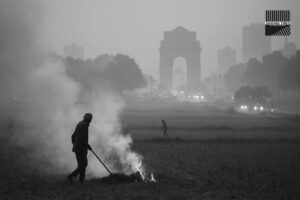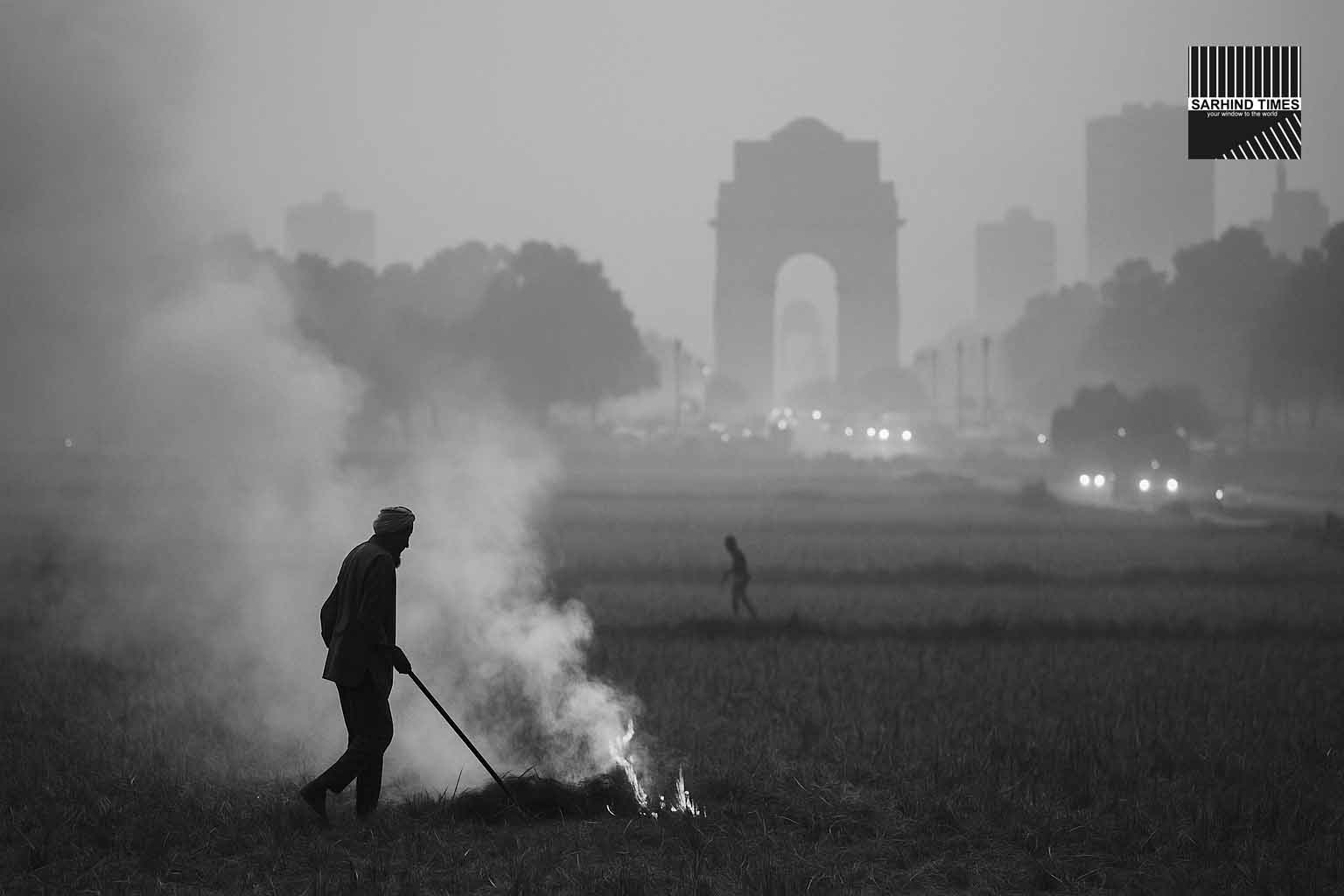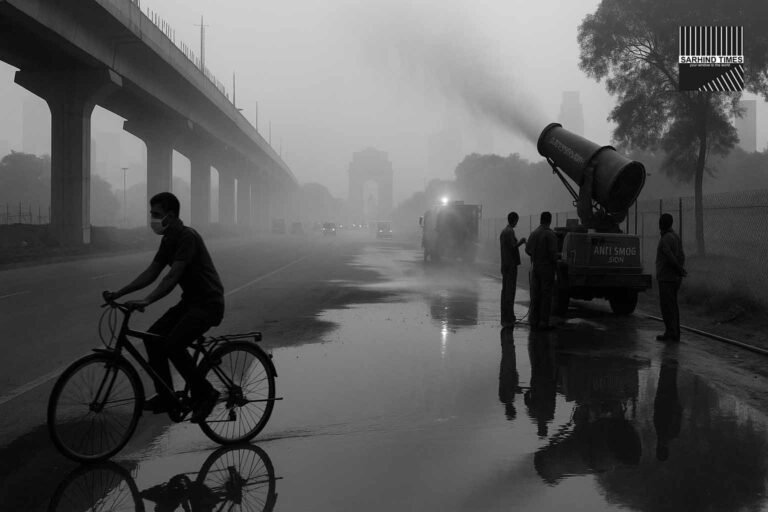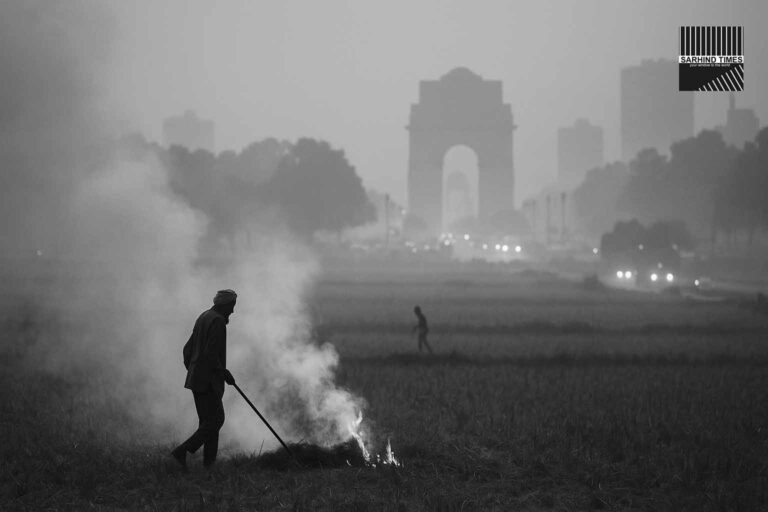By Sarhind Times Bureau | New Delhi | October 15, 2025
Introduction: The Smog Season Edges Closer
As autumn deepens across northern India, Delhi’s air quality index (AQI) once again slipped into the “poor” category on Tuesday, registering 211, according to the Central Pollution Control Board (CPCB). The data coincides with a fresh spike in farm-fire detections across six northern states, raising early alarms for the capital and the wider National Capital Region (NCR).
The Commission for Air Quality Management (CAQM) confirmed that authorities have initiated Stage-1 of the Graded Response Action Plan (GRAP) to curb emissions from dust, vehicles, and construction sites.
While official statistics show that the number of farm fires so far this year remains lower than in previous seasons, meteorologists caution that even small-scale burning events, when combined with stagnant winds and temperature inversion, can severely impact air quality in Delhi.
Farm-Fire Data: A Measured Start to a Known Crisis
According to the latest data from the Indian Agricultural Research Institute (IARI) and remote-sensing satellites, a total of 552 stubble-burning incidents were detected between September 15 and October 14 across Punjab, Haryana, Uttar Pradesh, Delhi, Rajasthan, and Madhya Pradesh.
The state-wise breakdown is as follows:
- Uttar Pradesh: 225 incidents
- Punjab: 165 incidents
- Haryana: 95 incidents
- Rajasthan: 37 incidents
- Madhya Pradesh: 21 incidents
- Delhi: 9 incidents
Officials attribute the lower overall count to delayed harvesting due to unseasonal rains and improved adoption of straw-management techniques in some regions. However, experts say the coming fortnight will be decisive as harvesting accelerates in Punjab and Haryana — the two states traditionally responsible for the bulk of stubble fires.
“The real test will come after October 20 when the paddy harvest peaks. If containment measures hold then, Delhi might avoid another severe smog episode,” said Dr. Gufran Beig, founder project director at SAFAR-India.
Delhi’s AQI: The First Warning Sign
Tuesday’s AQI reading of 211 placed Delhi firmly in the ‘poor’ category, triggering the first tier of the Graded Response Action Plan (GRAP) — a legally enforceable pollution-control framework active across NCR.
The deterioration, according to CPCB scientists, stemmed from a combination of local emissions — construction dust, vehicular exhaust, and open waste burning — and transboundary smoke drift from initial farm-fire clusters in western Uttar Pradesh and northern Punjab.
“The atmospheric boundary layer is shrinking due to lower night-time temperatures, trapping pollutants near the surface,” said a senior IMD official. “Even limited fire activity can push Delhi’s AQI into the poor zone under calm conditions.”
Authorities have now instructed mechanical road-sweeping teams to intensify operations and construction sites to deploy anti-smog guns.
GRAP Stage-1 Measures: The Capital’s First Line of Defence
Under Stage-1, the following measures have come into force across Delhi-NCR:
- Strict dust control protocols at all construction and demolition sites.
- Mandatory covering of trucks carrying construction material.
- Ban on open waste burning and strict penalties for violations.
- 24×7 helplines for pollution-related complaints.
- Increased frequency of mechanised road sweeping and water sprinkling on arterial roads.
- Promotion of carpooling and public transport through advisories to institutions and offices.
Local bodies, including the Municipal Corporation of Delhi (MCD), NDMC, and Noida Authority, have been directed to submit daily compliance reports to the CAQM.
“The intent is to act early, not react late,” said a senior CAQM official. “Stage-1 interventions are preventive, designed to slow down accumulation before the crisis peaks.”
Meteorological Conditions: Calm Winds, Cool Nights
Meteorologists say that seasonal transition has created a meteorological trap conducive to pollution build-up.
The region has experienced low wind speeds (below 5 km/h) and rising humidity levels over the past week.
Night-time temperature inversion layers — where cooler air near the ground is trapped under warmer air above — prevent pollutants from dispersing vertically.
“This is a textbook setup for smog formation,” explained Dr. Naresh Kumar, IMD climatologist. “When combined with farm-fire smoke and vehicular exhaust, the city’s air quickly becomes toxic.”
The IMD predicts similar conditions through late October, with no major wind shift or rainfall expected to disperse pollutants.
Farm-Fire Dynamics: Why Numbers Matter Less Than Timing
While the 552 incidents logged so far represent a year-on-year decline, scientists warn that the pattern and timing of fires matter more than absolute numbers.
If large-scale burning coincides with unfavourable meteorological conditions, even limited fires can spike AQI levels across the region.
This is particularly true when wind trajectories shift from northwest to east, funnelling smoke directly toward Delhi.
In 2023, for instance, satellite data recorded around 70,000 farm fires over two months, with Delhi witnessing 13 consecutive days of ‘very poor’ air despite lower fire intensity than 2022.
“Air quality in Delhi is not linear—it’s meteorologically amplified,” said Prof. Saroj Dahiya, environmental scientist at TERI. “A thousand fires at the wrong time can do more damage than ten thousand spread evenly.”
Government Response: From Subsidies to Enforcement
State governments have rolled out a mix of financial incentives, enforcement drives, and equipment subsidies to curb stubble burning.
Key measures include:
- Punjab: Distribution of over 1.3 lakh crop residue management machines including Super Seeders and Happy Seeders.
- Haryana: In-situ decomposition pilot using the Pusa Bio-Decomposer, sprayed over 8 lakh acres.
- Uttar Pradesh: Deployment of rapid-response teams to seize straw-burning machinery and impose fines.
However, farmers continue to cite high operational costs and tight harvesting-to-sowing windows as barriers to compliance.
“Most small farmers can’t afford the time or diesel to manage residues properly,” said Balbir Singh, a farmer from Patiala. “Without quick subsidies or ready-to-use services, burning becomes the only option.”
The Economics of Straw Management
Analysts argue that sustainable stubble management requires not just penalties but viable value chains.
Crop residue, if processed correctly, can feed into bioenergy plants, composting units, or cattle fodder supply chains.
The Union Ministry of Power recently approved co-firing crop residue pellets in thermal power stations, while private firms are investing in bio-CNG plants in Punjab and Haryana.
But these solutions are still at an early stage. Only a fraction of the total residue generated—estimated at 27 million tonnes annually across North India—is currently repurposed.
“Unless the economics work for farmers, the problem will persist,” said Ramesh Chand, member of NITI Aayog. “We need farm-gate collection models supported by cooperatives and industry partnerships.”
Health Advisory: Citizens Urged to Take Precautions
With AQI slipping into the poor category, medical experts have issued advisories urging residents—especially those with respiratory or cardiac conditions—to limit outdoor exposure.
Recommended precautions include:
- Using N95 masks during peak traffic hours.
- Keeping air purifiers operational in enclosed spaces.
- Avoiding morning walks near arterial roads.
- Staying hydrated and maintaining indoor ventilation filters.
Hospitals across Delhi have reported a 15% uptick in respiratory complaints over the past week, particularly among children and the elderly.
“Pollution acts as a slow poison,” said Dr. Rakesh Gupta, pulmonologist at AIIMS. “Even moderate AQI levels can trigger inflammation and long-term lung damage with repeated exposure.”
Environmentalists: Call for Long-Term Vision
Activists argue that seasonal firefighting won’t solve a recurring crisis that combines agricultural policy failures, urban mismanagement, and weak enforcement.
“We’re still treating air pollution as a winter issue instead of a year-round governance failure,” said Sunita Narain, Director General, Centre for Science and Environment (CSE).
“The solution lies in agricultural diversification, clean mobility, and sustained citizen participation.”
CSE and Greenpeace India have called for real-time transparency dashboards linking air-quality data, enforcement actions, and satellite imagery for public monitoring.
Regional Coordination: NCR Cities Sync Messaging
The CAQM has directed all NCR cities—including Gurugram, Noida, Ghaziabad, and Faridabad—to synchronise air-quality messaging and advisories.
Local governments are asked to promote public transport, remote work options, and car-free days during high-AQI spells.
Some schools are already adjusting outdoor activity schedules, while private offices are encouraging hybrid work models on days when AQI crosses 250.
“Public cooperation is key,” said Vivek Chattopadhyay, program head at CSE. “Each car off the road or fire prevented upstream has measurable impact.”
Conclusion: A Familiar Battle, A Fragile Window
Delhi’s early descent into the poor air zone is both a warning and a window of opportunity.
With farm fires still low and Stage-1 curbs active, authorities have a brief chance to blunt the seasonal spiral before November’s smog peaks.
But success will depend on coordination — between states, ministries, and citizens.
In a city that has learned to live under haze, the challenge now is not endurance, but prevention.
For now, as the harvest smoke begins to rise over the northern plains, the capital once again holds its breath—literally and figuratively—hoping this winter will be different.
#DelhiAQI #StubbleBurning #GRAP #AirQuality #Environment #PollutionCrisis #CleanAir #NCR #ClimateAction #PublicHealth #SarhindTimes




















+ There are no comments
Add yours